Many random-number generators return floating numbers between 0 and 1.
What's the best and correct way to get integers between a and b?
Many random-number generators return floating numbers between 0 and 1.
What's the best and correct way to get integers between a and b?
Divide the interval [0,1] in B-A+1 bins
Example A=2, B=5
[----+----+----+----]
0 1/4 1/2 3/4 1
Maps to 2 3 4 5
The problem with the formula
Int (Rnd() * (B-A+1)) + A
is that your Rnd() generation interval is closed on both sides, thus the 0 and the 1 are both possible outputs and the formula gives 6 when the Rnd() is exactly 1.
In a real random distribution (not pseudo), the 1 has probability zero. I think it is safe enough to program something like:
r=Rnd()
if r equal 1
MyInt = B
else
MyInt = Int(r * (B-A+1)) + A
endif
Edit
Just a quick test in Mathematica:
Define our function:
f[a_, b_] := If[(r = RandomReal[]) == 1, b, IntegerPart[r (b - a + 1)] + a]
Build a table with 3 10^5 numbers in [1,100]:
table = SortBy[Tally[Table[f[1, 100], {300000}]], First]
Check minimum and maximum:
In[137]:= {Max[First /@ table], Min[First /@ table]}
Out[137]= {100, 1}
Lets see the distribution:
BarChart[Last /@ SortBy[Tally[Table[f[1, 100], {300000}]], First],
ChartStyle -> "DarkRainbow"]

X = (Rand() * (B - A)) + A
Another way to look at it, where r is your random number in the range 0 to 1:
(1-r)a + rb
As for your additional requirement of the result being an integer, maybe (apart from using built in casting) the modulus operator can help you out. Check out this question and the answer:
Well, why not just look at how Python does it itself? Read random.py in your installation's lib directory.
After gutting it to only support the behavior of random.randint() (which is what you want) and removing all error checks for non-integer or out-of-bounds arguments, you get:
import random
def randint(start, stop):
width = stop+1 - start
return start + int(random.random()*width)
Testing:
>>> l = []
>>> for i in range(2000000):
... l.append(randint(3,6))
...
>>> l.count(3)
499593
>>> l.count(4)
499359
>>> l.count(5)
501432
>>> l.count(6)
499616
>>>
Assuming r_a_b is the desired random number between a and b and r_0_1 is a random number between 0 and 1 the following should work just fine:
r_a_b = (r_0_1 * (b-a)) + a